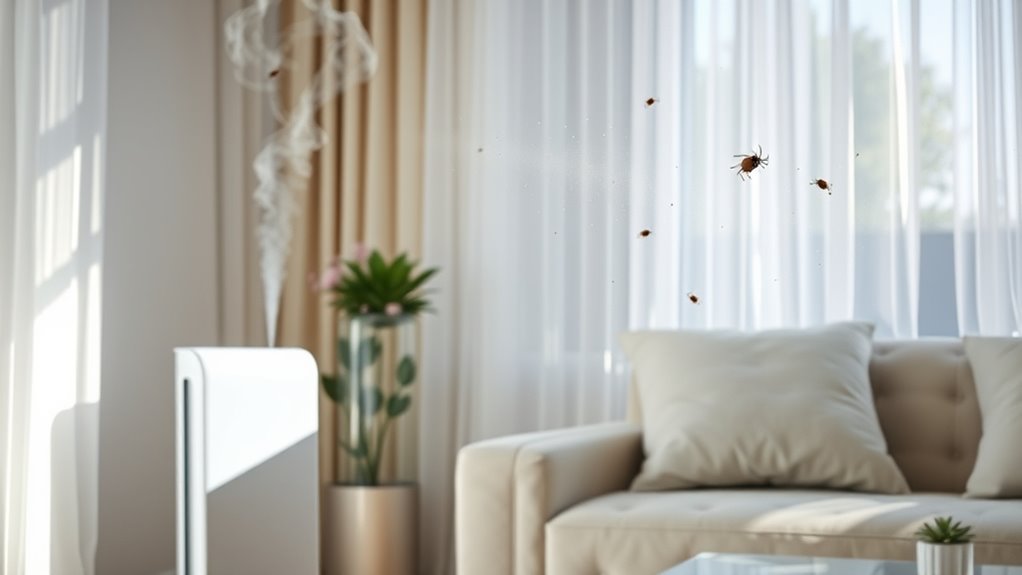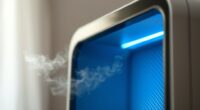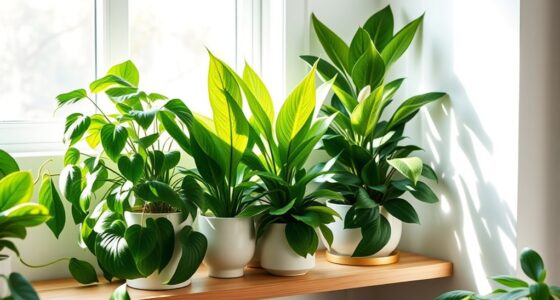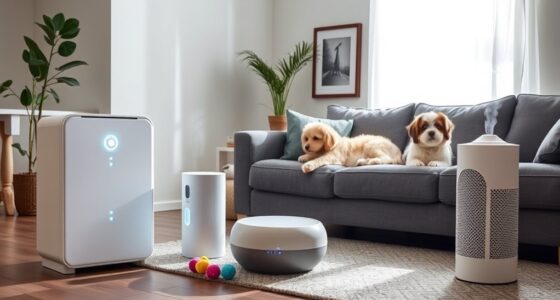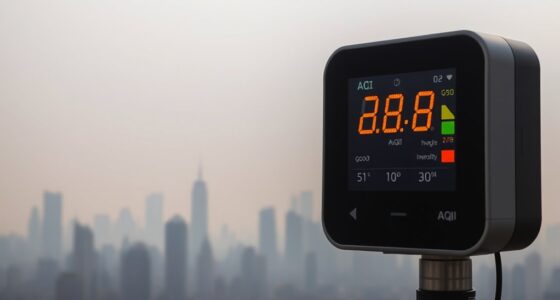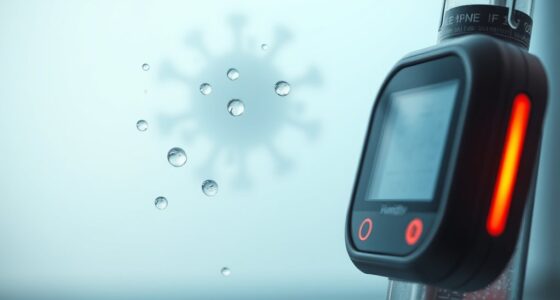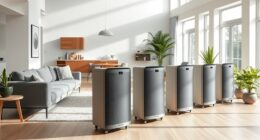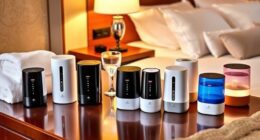Using air purifiers and humidifiers together can greatly improve your indoor air quality and reduce allergy symptoms. Air purifiers with HEPA filters trap allergens like pollen, pet dander, and dust mites, while humidifiers add moisture to ease nasal and throat irritation and prevent dust mites and mold growth. When placed properly and maintained regularly, these devices create a cleaner, more comfortable environment. If you keep exploring, you’ll discover how to make the most of their combined benefits.
Key Takeaways
- Air purifiers with HEPA filters remove airborne allergens like pollen, pet dander, and dust mites, reducing allergy triggers indoors.
- Humidifiers increase indoor humidity to soothe nasal tissues and prevent dryness, easing allergy symptoms.
- Combining both devices balances humidity and air cleanliness, minimizing mold growth and allergen proliferation.
- Proper placement, regular cleaning, and filter replacement ensure optimal performance and long-term allergy relief.
- Monitoring indoor humidity levels with a hygrometer helps maintain ideal conditions (40-50%) for allergy reduction.
Understanding Air Purifiers and Their Role in Allergy Relief
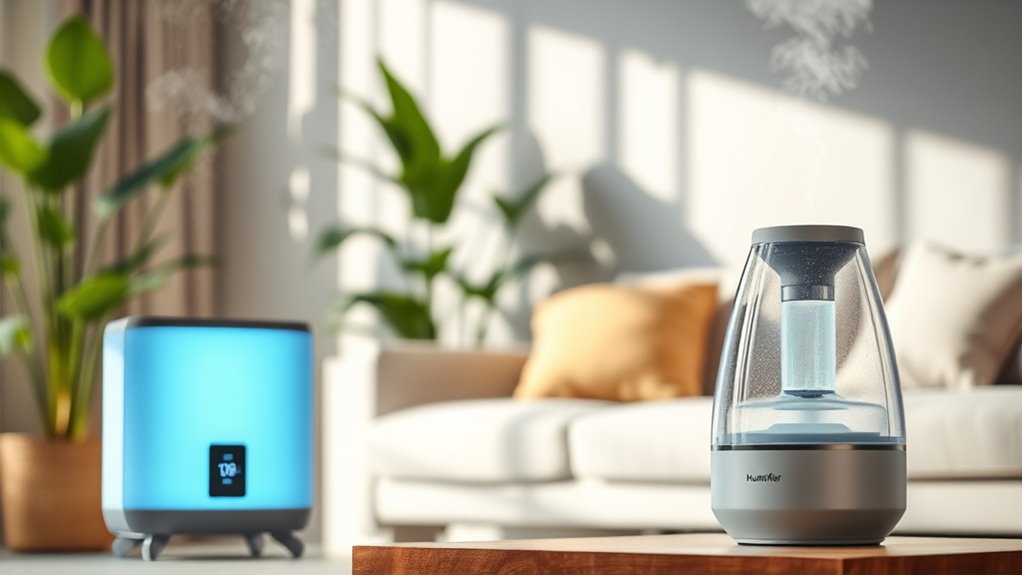
Have you ever wondered how air purifiers can help reduce allergy symptoms? It all comes down to air purifier technology and allergen filtration. Modern air purifiers use HEPA filters, capable of capturing tiny particles like pollen, pet dander, and dust mites. These filters improve indoor air quality by trapping allergens that trigger your allergies. When you turn on an air purifier, it continuously pulls in air, filters out harmful particles, and releases cleaner air back into your space. This process helps reduce airborne allergens, making breathing easier and lessening allergy flare-ups. Understanding how air purifier technology works can empower you to choose the right device, creating a healthier environment and easing allergy symptoms effectively. Regular filter replacement, typically every 6-12 months, is essential to maintain optimal performance HEPA filtration.
How Humidifiers Help Alleviate Allergy Symptoms
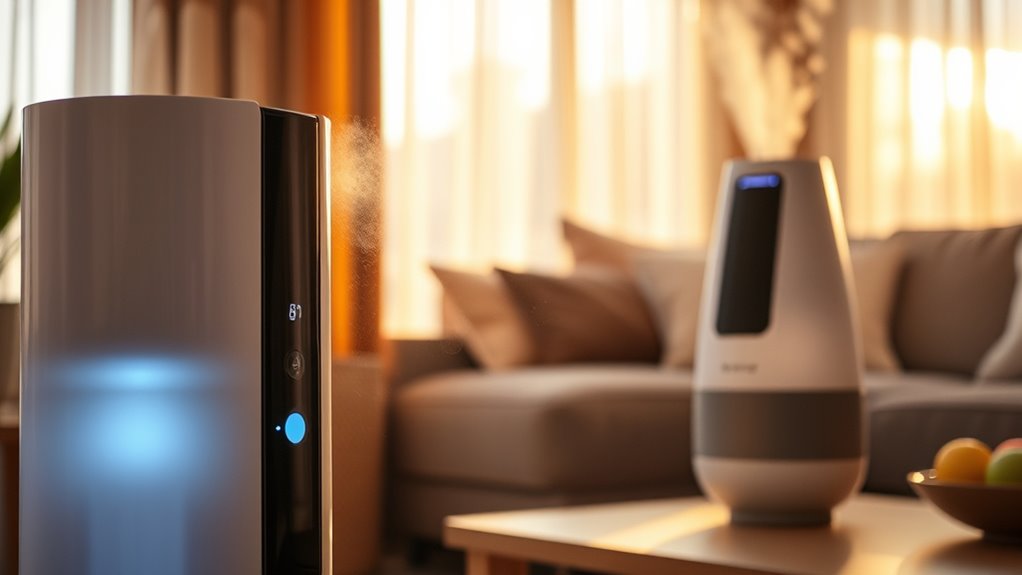
When indoor air is too dry, it can worsen allergy symptoms by irritating your nasal passages and throat. Humidifiers help by increasing humidity levels, which aids in humidity control and reduces airborne allergens. Proper moisture prevents allergens like dust mites and mold from thriving, decreasing their presence. Additionally, moist air soothes irritated nasal tissues and alleviates dry, scratchy throats. Use a hygrometer to monitor humidity and keep it between 40-50%. Here’s how humidifiers make a difference: humidity levels are crucial for maintaining optimal indoor air quality and preventing allergy flare-ups.
| Effect of Humidifiers | Benefits for Allergies |
|---|---|
| Reduces airborne allergens | Limits dust mites and mold growth |
| Moistens nasal passages | Eases congestion and irritation |
| Prevents dry skin | Keeps skin hydrated and healthy |
| Maintains humidity control | Supports overall respiratory health |
The Synergistic Effect of Combining Air Purifiers and Humidifiers
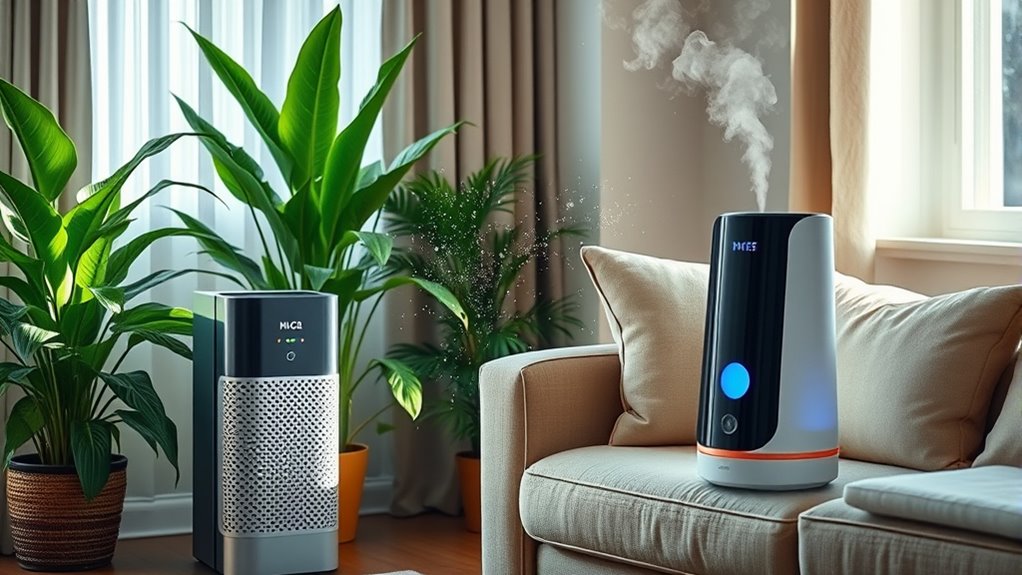
Using both an air purifier and a humidifier can substantially improve your indoor air quality and help reduce allergy symptoms. When combined, they work together to remove allergens and maintain balanced humidity levels, making the air more comfortable to breathe. This synergy creates a healthier environment, easing your allergy relief efforts. Incorporating devices with advanced filtration technology further enhances these benefits by capturing up to 99.97% of airborne particles.
Improved Air Quality
Combining air purifiers with humidifiers creates a powerful synergy that considerably enhances indoor air quality. When you use air quality sensors, you can monitor pollutant levels and adjust your devices for ideal results. The air purifier filters out airborne allergens, dust, and pollutants, while the humidifier maintains perfect moisture levels, preventing dry air that can aggravate respiratory issues. This combination ensures a cleaner environment, reducing airborne irritants that can worsen allergy symptoms. With allergen filtration working alongside humidity control, you create a healthier space that minimizes airborne particles and maintains consistent air quality. Regularly checking for signs of allergy symptoms can help you determine if your air quality setup is effectively reducing triggers. This integrated approach helps you breathe easier and promotes overall well-being by actively improving indoor air conditions.
Reduced Allergy Symptoms
By actively integrating air purifiers with humidifiers, you can considerably reduce allergy symptoms. Air purifier technology captures airborne allergens like pollen, dust mites, and pet dander, preventing them from triggering reactions. Meanwhile, maintaining your humidifier properly guarantees it operates efficiently, adding moisture that soothes irritated nasal passages and reduces airborne dust. When used together, these devices work synergistically: the air purifier filters allergens from the air, and the humidifier maintains ideal humidity levels to prevent dry, irritated sinuses. Regular humidifier maintenance, such as cleaning and replacing filters, keeps mold and bacteria at bay, making sure you’re not introducing new allergens. This combined approach creates a cleaner, more comfortable environment that actively minimizes allergy symptoms, helping you breathe easier and feel better daily. Incorporating AI-powered devices into your home can further optimize air quality management, tailoring solutions to your specific needs.
Balanced Humidity Levels
Achieving balanced humidity levels is essential for maximizing allergy relief when you use air purifiers and humidifiers together. Proper humidity control improves air quality by preventing mold growth, dust mites, and other allergens that thrive in too-dry or too-humid environments. When humidity is too low, your nasal passages can dry out, making allergy symptoms worse. Conversely, excessive humidity encourages mold and mildew, which can worsen allergies. Maintaining a humidity level between 40-50% creates an ideal environment for allergy sufferers. This balance ensures your air purifier can effectively filter airborne allergens while your humidifier adds moisture where needed. Using a hygrometer to monitor indoor humidity levels helps maintain this optimal range. Together, they create a healthier indoor environment, reducing allergens and improving overall air quality for allergy relief.
Selecting the Right Air Purifier for Your Allergy Needs
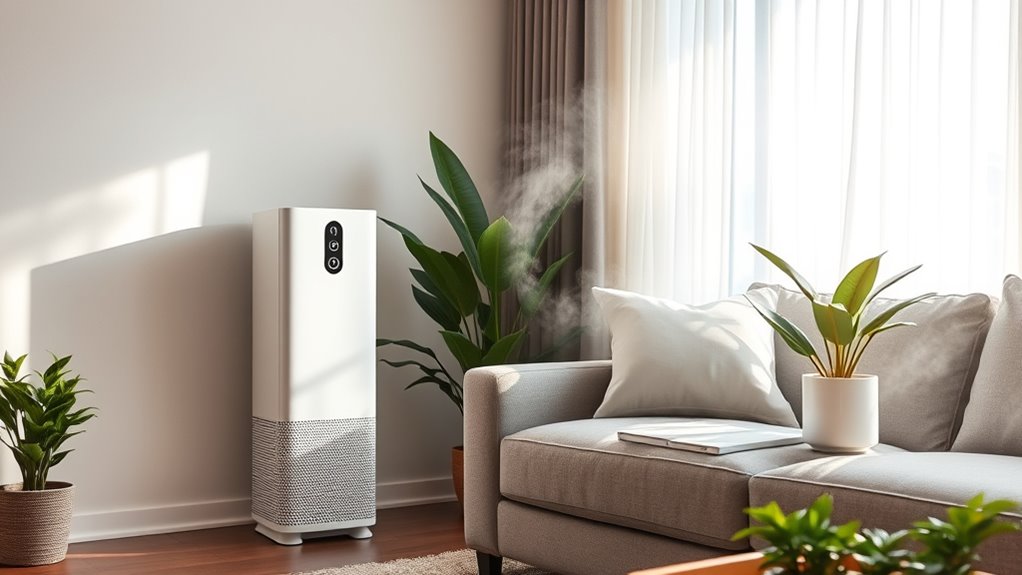
Choosing the right air purifier is essential for effectively reducing allergy triggers in your home. Look for models with HEPA filters, as they trap airborne particles like pollen, dust mites, and pet dander, providing cleaner air. Consider noise levels too; quieter units won’t disturb your daily activities or sleep. Some air purifiers operate quietly on lower settings, making them ideal for bedrooms or living spaces. Make sure the purifier covers the size of your room to ensure maximum performance. Also, check for easy filter replacements and energy efficiency. By selecting a purifier with effective HEPA filtration and manageable noise levels, you’ll create a healthier environment that minimizes allergy symptoms and promotes better overall comfort. Sulfate-free options are also worth considering to prevent further skin and scalp irritation from harsh chemicals.
Choosing an Appropriate Humidifier for Your Home

Selecting the right air purifier helps reduce airborne allergens, but maintaining proper indoor humidity levels is equally important for allergy relief. To do this effectively, you need to choose the right types of humidifiers. There are several options, such as evaporative, ultrasonic, and steam vaporizer models. Portable humidifiers are especially convenient because they can be moved easily between rooms and fit different spaces. When selecting a humidifier, consider the size of your room and your specific needs—whether you prefer a cool-mist or warm-mist device. Confirm it’s easy to clean to prevent mold and bacteria buildup. Additionally, understanding trust issues with partners can help ensure a healthier environment free from stress-related disruptions. Ultimately, the best humidifier for your home will help balance humidity levels, making your environment more comfortable and less allergenic.
Optimal Placement and Usage Tips for Maximum Effectiveness
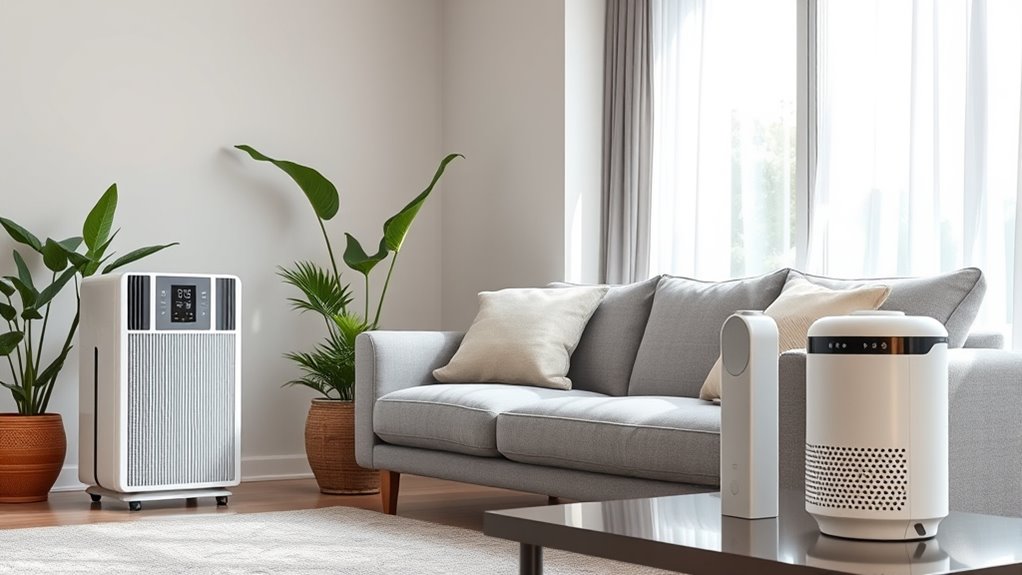
To guarantee your humidifier provides maximum allergy relief, it’s essential to position it correctly within your space. Place the device on a flat, elevated surface away from walls and furniture to promote airflow optimization. Keep it at a central location rather than in corners, ensuring evenly distributed humidity. Make sure the humidifier is properly calibrated; regularly check and adjust settings according to room size and humidity levels. This helps prevent over-humidification or dry spots, maintaining ideal moisture without creating mold or dust mites. Avoid placing it near air vents or direct sunlight, as these can interfere with performance. Proper placement and device calibration work together to maximize the humidifier’s effectiveness, creating a healthier environment and alleviating allergy symptoms more efficiently. Monitoring humidity levels with a hygrometer can further enhance effective operation and ensure optimal comfort.
Common Mistakes to Avoid When Using These Devices
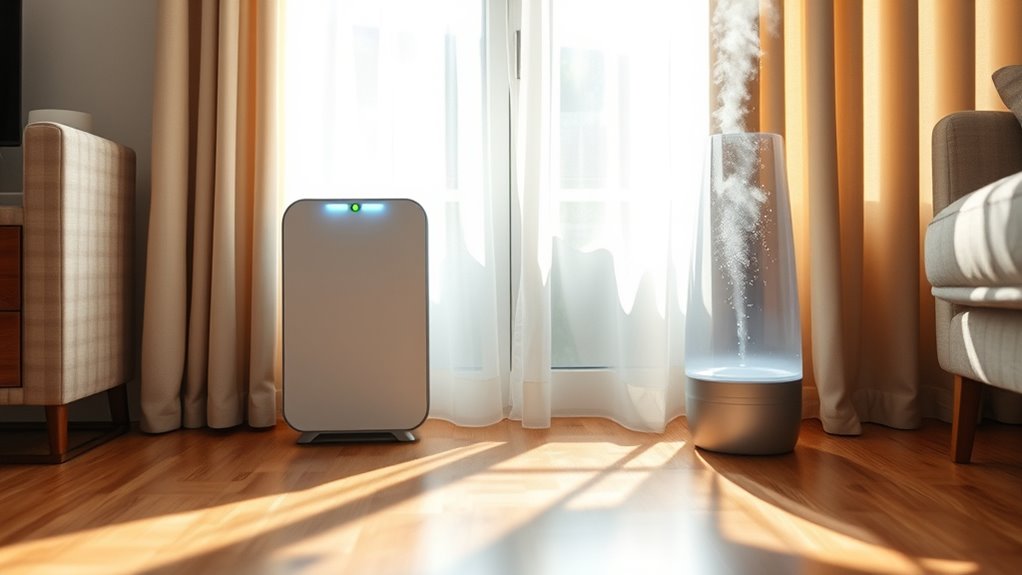
Many users make the mistake of neglecting regular maintenance, which can considerably reduce a humidifier’s effectiveness and even worsen allergy symptoms. Overuse hazards are a common issue—running your device continuously can lead to excessive humidity, fostering mold and bacteria growth. Also, avoid using incompatible devices together; for example, pairing a humidifier with an air purifier not suited for high humidity levels can cause damage or diminish efficiency. Here are three mistakes to watch out for:
- Ignoring filter or water tray cleaning, leading to bacteria buildup.
- Running devices at maximum settings nonstop, risking overuse hazards.
- Using incompatible devices that don’t work well together, causing damage or reduced allergy relief.
Stay vigilant to ensure safe, effective allergy relief.
Maintaining Your Air Purifier and Humidifier for Long-Term Benefits

To keep your air purifier and humidifier working effectively, you need to maintain them properly. Regularly change filters, clean the humidifier, and guarantee devices are placed in ideal spots. These simple steps can make a big difference in long-term allergy relief. Additionally, choosing appropriate security measures for your home can help protect your appliances and ensure your home environment remains safe and comfortable.
Regular Filter Changes
Regular filter changes are essential for guaranteeing your air purifier and humidifier work efficiently and effectively. Over time, allergen filters accumulate dust, pollen, and other particles, reducing their filter lifespan. Replacing filters regularly keeps your devices functioning at their best. Here’s what happens when you don’t change filters promptly:
- The allergen filters become clogged, limiting airflow and decreasing purification efficiency.
- Dirty filters can cause your devices to work harder, increasing energy use and wear.
- Reduced filter effectiveness means fewer allergens are captured, impacting your allergy relief.
- Maintaining proper filter function also influences the contrast ratio that affects overall image quality and device performance.
To maintain peak performance, check your allergen filters monthly and replace them according to the manufacturer’s recommendations. This simple step ensures your devices continue to provide clean, allergen-free air for your home.
Humidifier Cleaning Routine
Keeping your humidifier clean is essential for maintaining healthy air quality and ensuring it functions efficiently over time. Regular cleaning prevents mold, bacteria, and mineral buildup that can compromise air purifier maintenance and pose health risks. To start, unplug the device and empty any remaining water daily. Use mild soap and a soft brush to scrub the tank and components thoroughly, paying attention to corners and filters. Rinse well and dry completely before reassembling. Avoid harsh chemicals that could damage the device or reduce humidifier safety. Regular cleaning not only extends the lifespan of your humidifier but also guarantees it works effectively alongside your air purifier. Additionally, choosing an electric bike generator can help power your devices sustainably, reducing reliance on traditional energy sources. By maintaining a consistent cleaning routine, you help create a cleaner, healthier environment free of allergens and pollutants.
Proper Device Placement
Proper placement of your air purifier and humidifier is essential for maximizing their effectiveness and longevity. Correct positioning ensures ideal air circulation and prevents issues like mold or dust buildup. To achieve this, consider these tips:
- Place the air purifier away from walls and furniture to allow full airflow, aiding in air purifier maintenance.
- Position the humidifier on a flat, water-resistant surface, keeping it out of reach of children for humidifier safety.
- Keep both devices at least a few feet from electronic devices and vents to avoid interference and ensure they work efficiently.
- Being transparent about affiliate commissions earned from product links helps maintain trust and ensures informed purchasing decisions.
Proper placement not only enhances performance but also reduces risks. Regularly check your devices to maintain ideal air quality and safety, ensuring long-term allergy relief benefits.
Frequently Asked Questions
Can Air Purifiers Remove All Types of Airborne Allergens?
Air purifiers can’t remove all types of airborne allergens because their filter effectiveness varies. They are great at capturing common allergens like pollen, pet dander, and dust mites, but some airborne allergen types, like certain mold spores or tiny particles, may slip through. To maximize relief, choose an air purifier with a high-efficiency filter, such as HEPA, and use it consistently alongside other allergy management strategies.
How Often Should I Clean or Replace Filters in These Devices?
Think of your air purifier and humidifier as loyal guardians—keeping watch over your air quality. For ideal filter maintenance, check filters monthly and replace them every 3 to 6 months, depending on usage and air quality. Regular upkeep extends your device lifespan and guarantees they work effectively. Don’t forget, neglecting filter changes is like ignoring a good friend’s advice—it weakens their ability to protect you.
Are There Specific Humidity Levels Ideal for Allergy Relief?
You should aim for an ideal humidity level of between 30% and 50% to relieve allergies. Maintaining this range helps prevent mold growth and dust mites, which thrive in higher humidity. Using a humidifier and air purifier together can help you control indoor moisture levels effectively. Regularly monitor humidity with a hygrometer, and adjust your devices to keep the environment comfortable and allergen-free.
Can Using Both Devices Increase Energy Consumption Significantly?
Imagine you’re back in the 90s with dial-up internet—using both devices can boost your energy consumption, but it usually isn’t significant if your devices are energy-efficient. Modern air purifiers and humidifiers are designed to run efficiently, so their combined energy use remains manageable. While they do consume extra power, their benefits for allergy relief outweigh the slight increase in energy consumption. Always check device labels for efficiency ratings to keep costs low.
What Safety Precautions Should I Follow When Operating Air Purifiers and Humidifiers?
When operating air purifiers and humidifiers, you should prioritize electrical safety by plugging them into grounded outlets and avoiding overloading circuits. Be mindful of device placement; keep air purifiers on flat, stable surfaces away from water sources, and place humidifiers on level surfaces to prevent spills. Regularly clean and maintain both devices to prevent mold and bacteria growth, ensuring safe and effective allergy relief.
Conclusion
Think of your home as a garden—you need the right tools to keep it thriving. Using an air purifier and humidifier together is like tending to your plants with water and sunlight, creating the perfect environment. When you choose and use them wisely, allergy symptoms can fade like weeds in a well-maintained garden. With a little effort, you’ll breathe easier and enjoy a healthier, more comfortable space every day.
